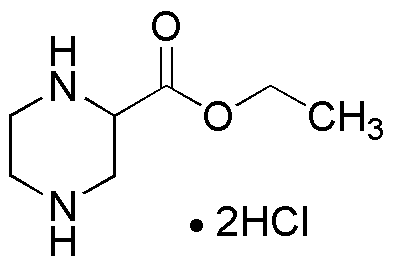2-Piperazinecarboxylic acid ethyl ester dihydrochloride is widely utilized in research focused on:
- Pharmaceutical Development: This compound serves as a key intermediate in the synthesis of various pharmaceuticals, particularly those targeting neurological disorders. Its structure allows for modifications that enhance drug efficacy.
- Biochemical Research: It is used in studies related to enzyme inhibition and receptor binding, providing insights into biochemical pathways and potential therapeutic targets.
- Material Science: The compound is explored for its potential in developing new polymers and materials that require specific chemical properties, such as flexibility and durability.
- Agricultural Chemistry: It finds applications in the formulation of agrochemicals, contributing to the development of safer and more effective pesticides and herbicides.
- Analytical Chemistry: This chemical is used as a standard in various analytical methods, helping researchers ensure accuracy in their measurements and results.
General Information
Properties
Safety and Regulations
Applications
2-Piperazinecarboxylic acid ethyl ester dihydrochloride is widely utilized in research focused on:
- Pharmaceutical Development: This compound serves as a key intermediate in the synthesis of various pharmaceuticals, particularly those targeting neurological disorders. Its structure allows for modifications that enhance drug efficacy.
- Biochemical Research: It is used in studies related to enzyme inhibition and receptor binding, providing insights into biochemical pathways and potential therapeutic targets.
- Material Science: The compound is explored for its potential in developing new polymers and materials that require specific chemical properties, such as flexibility and durability.
- Agricultural Chemistry: It finds applications in the formulation of agrochemicals, contributing to the development of safer and more effective pesticides and herbicides.
- Analytical Chemistry: This chemical is used as a standard in various analytical methods, helping researchers ensure accuracy in their measurements and results.
Documents
Safety Data Sheets (SDS)
The SDS provides comprehensive safety information on handling, storage, and disposal of the product.
Product Specification (PS)
The PS provides a comprehensive breakdown of the product’s properties, including chemical composition, physical state, purity, and storage requirements. It also details acceptable quality ranges and the product's intended applications.
Certificates of Analysis (COA)
Search for Certificates of Analysis (COA) by entering the products Lot Number. Lot and Batch Numbers can be found on a product’s label following the words ‘Lot’ or ‘Batch’.
*Catalog Number
*Lot Number
Certificates Of Origin (COO)
This COO confirms the country where the product was manufactured, and also details the materials and components used in it and whether it is derived from natural, synthetic, or other specific sources. This certificate may be required for customs, trade, and regulatory compliance.
*Catalog Number
*Lot Number
Safety Data Sheets (SDS)
The SDS provides comprehensive safety information on handling, storage, and disposal of the product.
DownloadProduct Specification (PS)
The PS provides a comprehensive breakdown of the product’s properties, including chemical composition, physical state, purity, and storage requirements. It also details acceptable quality ranges and the product's intended applications.
DownloadCertificates of Analysis (COA)
Search for Certificates of Analysis (COA) by entering the products Lot Number. Lot and Batch Numbers can be found on a product’s label following the words ‘Lot’ or ‘Batch’.
*Catalog Number
*Lot Number
Certificates Of Origin (COO)
This COO confirms the country where the product was manufactured, and also details the materials and components used in it and whether it is derived from natural, synthetic, or other specific sources. This certificate may be required for customs, trade, and regulatory compliance.


